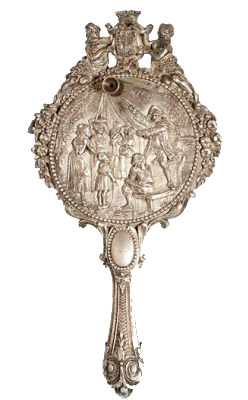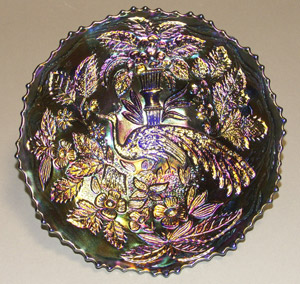
JEFFERSON CITY, Mo. (AP) – Salt dips?
Stanhope viewers?
You collect … what?
Those are frequent questions from friends and acquaintances to members of the River City Collectors Guild. They get some curious looks, too. But when they come together for their monthly meetings, they find like-minded people.
“They don’t think you’re crazy,” said Bobbie Herman, who collects salt dips. Salt dips, or salt cellars, were used before salt shakers, when salt was more precious. They often came with tiny spoons and were kept near the head of the table.
John Poehlein collects the rare Stanhope viewers, named after the inventor who placed miniature photos, some risqué or political, inside trinkets with a tiny hole to look through when held to the light.
“It’s something exclusive; 99 out of 100 people don’t know what a Stanhope is, even collectors,” Poehlein said.
Poehlein garners surprise for his collection of items related to and books by Edgar Rice Burroughs, author of Tarzan.
“People do look at me cross-eyed when I tell them,” he said. “(But) it’s an ego boost.”
The guild celebrates together when a member brings the latest “find” from their treasure hunts through antique stores and flea markets.
“I’m jealous of some of their collections,” Poehlein said. “They have some really neat stuff.”
Bargain-hunting and browsing are half the fun.
“You get driven,” Poehlein said. “You can’t wait to get there, to see what you can find.”
Judie Didriksen, who collects china, agreed.
“It’s the thrill of finding the piece you’ve been looking for or a real bargain,” she said.
And once the bounty has been found, Alice Fast said she enjoys looking over her collection again.
“It really is the thrill of the hunt – what’s around the next corner or in the next booth,” said Fast, who collects handkerchiefs.
Once at a mall in Kansas City, Fast “hit the jackpot” with a basket full of 1950s crocheted handkerchiefs. She said she was so excited she had to limit her spending for the day.
The guild’s mission statement says if you have three or more of anything, you have a collection.
“If it was made to be used, somebody is collecting it,” said Poehlein, also an antique dealer. “It doesn’t matter how silly it is.”
Many times a collection begins with sentimental ties.
Herman started collecting as a young mother new to the community looking for a social outlet. So, many of her salt dips hold memories of friends and those experiences.
“Your first collection is always the dearest,” Herman said. “It was bringing home a little treasure, that didn’t cost a great deal.”
For Didriksen, it was her grandmother’s mixing bowl that produced homemade bread and biscuits. Today she mixes cakes in the same Autumn Leaf-pattern bowl for her family.
But she discovered the Jewel Tea Co. issued plates, cups and saucers, dinner settings, tins and many other kitchen items as premiums. And she was hooked.
The history of the first fresh coffee company drew her in even more. She was intrigued by how the Jewel Tea Co. began as one man and a horse-drawn wagon and 10 years later was a million-dollar business.
Most of these collectors don’t collect as an investment, nor do they add any piece just to increase their numbers.
“I’ve always been interested in history,” Herman said. “It’s amazing what you can learn from this stuff.
“For me, it’s how much you can learn, not how much you can acquire.”
Many of the members have amassed such collections that they wait until they find something special to add.
“When you start a collection, you find all you can,” Fast said. “As you learn more, you might differentiate by quality.”
And sometimes pieces no longer are available.
Poehlein has a collection of old chewing gum packages and promotional items. His favorite is a 1930s pack of Indian brand trading cards with the rare original wrapper, which he found buried in the bottom of a miscellaneous box at an auction.
“Oh man, I guarded it all day long to make sure nobody messed with it,” Poehlein said.
Fast said she has similar trouble finding more additions for her Sun Bonnet Babies collection.
Collectors can be easy and difficult to buy gifts for. Where Herman’s children can buy one more piece to add to her Zell dinnerware collection, Fast’s friends might have a hard time finding a Jefferson City postcard she doesn’t already have.
But Didriksen’s husband found a long sought-after Autumn Leaf teapot at a summertime national convention and managed to hide it until Christmas.
“That was fun,” she said.
Copyright 2009. All rights reserved. This material may not be published, broadcast, rewritten or redistributed.
AP-CS-01-30-09 0106EST


